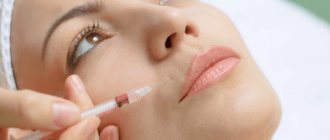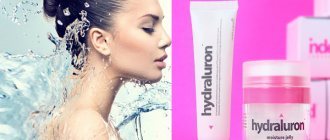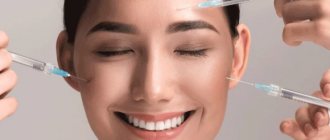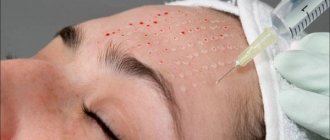Young, fresh, well-groomed skin is the dream of every woman. As the years pass, the real struggle for a blooming, impeccable appearance begins. If you previously had to resort to plastic surgery, today you can effectively restore youth with the help of injection cosmetology. Thanks to the procedures, the deep layers of the dermis are saturated with nutrients. The formulas are enriched with active substances that have moisturizing, regenerating, and whitening properties.
Mesotherapy and biorevitalization are popular procedures; the cosmetologist decides which type to choose. The specialist takes into account such characteristics as age, skin structure, problems that need correction. The methods allow you to slow down the aging process, improve the appearance of the skin, and cope with cosmetic defects. What is better - mesotherapy and biorevitalization, is there a difference between the procedures? Patients should also know.
What do you need to know about the mesotherapy procedure?
The name of the procedure speaks for itself: the drug is injected into the mesoderm - the intermediate layer of the skin.
The substance used is a real cocktail of medicinal and homeopathic remedies. They are mixed in certain proportions in accordance with the condition of the skin and the individual characteristics of the body of a particular woman.
The basis of most drug mixtures is hyaluronic acid of animal origin, to which peptides, amino acids, vitamins, minerals and other medicinal components are added.
Microinjections themselves, which are carried out with special thinnest needles, also have a stimulating effect, since the skin responds to traumatic effects with active metabolic and regenerative processes.
It becomes more elastic and resilient, and to achieve the desired result it is not at all necessary to introduce the mixture of ingredients exactly into the problem area.
The doctor chooses the place from where the active substance, thanks to intercellular communication, will act most effectively.
Mesotherapy has varieties depending on the purpose for which the injections are carried out, the method of administering the drug and the effect on the body. Thus, aesthetic and clinical mesotherapy, hardware and manual, as well as general, systemic, loco-regional and local are distinguished.
How to replace biorevitalization - an alternative and advice from cosmetologists
You can preserve youth using other methods. Alternative methods of rejuvenation are ultrasound or microcurrent phoresis, electroporation and various physiotherapeutic manipulations. To eliminate cosmetic problems, you can turn to salon procedures that will help maintain smoothness and elasticity of the skin.
The safest and most effective rejuvenation measures are:
- Photorejuvenation is a laser procedure to eliminate defects.
- Radio lifting is a non-surgical method of aesthetic cosmetology.
- Darsonvalization is treatment using physical factors.
- Laser, ultrasound or vacuum therapy.
- SPA - masks, compresses and wraps.
What is better - facial massage or biorevitalization
Biorevitalization has a significant drawback - the skin gradually gets used to the anti-aging product. As a result of frequent injections, the need for natural production of hyaluronic acid is reduced. If you refuse to administer the drug, the dermis will quickly lose elasticity and become loose and saggy.
Massage has a beneficial effect on all layers of the dermis. Thanks to increased blood flow and oxygen saturation, the skin will acquire a healthy glow and become smooth and elastic. Massage is similar in effectiveness to biorevitalization, but with regular care the results will be more lasting. In combination with other cosmetic procedures that maintain skin tone, massage will prevent premature aging. You can learn about biorevitalization for the face in cosmetology by following the link.
Plasma therapy for face
Plasma therapy or autorejuvenation is a popular method of rejuvenation. The principle of the technique is to introduce into the epidermis a drug created on the basis of the patient’s blood plasma. Tissue cells enriched with growth factors provide a lasting effect. As a result of the manipulations, the dermis is cleared of pigment spots and receives the necessary hydration.
Plasma therapy is recommended to eliminate problems such as: microcracks, wrinkles, microtraumas, scars, stretch marks and scars. The advantages of the technique include complete biocompatibility of the administered drug and the absence of allergic reactions.
Mesothreads
The essence of the technique is to insert mesothreads into the middle layers of the dermis. The frame base is made of polydiaxonone, which breaks down over time into carbon dioxide and water. The effect manifests itself in two types: mechanical tension in the problem area and the production of its own collagen in the tissues.
The visual effect of a facelift lasts up to 2 years. Indications for rejuvenation using mesothreads are:
- sagging skin;
- deep wrinkles;
- pronounced nasolabial folds;
- sagging of the upper layer of the dermis as a result of sudden weight loss;
- ptosis of the corners of the eyes, lips, eyebrows.
The technique is suitable for rejuvenation at any age, when the dermis begins to lose its natural firmness and elasticity. There are microcurrent therapy machines for home use.
Microcurrents - what is the difference with biorevitalization, is it possible to combine
Is it possible to combine? Microcurrent therapy refers to physical methods of influencing the dermis. Microcurrents are used in medical and cosmetic therapy to restore intracellular metabolism and supply tissues with oxygen. The effect on the body of modulated pulse currents provides the required energy for all biochemical reactions that occur in the body.
Unlike biorevitalization, microcurrent therapy has many contraindications. These include: somatic diseases, the presence of a pacemaker or implants, varicose veins, etc. However, this technique can be combined with “beauty injections” without causing side effects. For rejuvenation using both procedures, it is recommended to first resort to biorevitalization and after 7-9 days begin microcurrent sessions.
What is the difference between procedures against age-related changes on the face - bioreparation from biorevitalization
One of the main differences is the composition of the drugs administered. Biologically active substances are used for bioreparation injections: vitamins, amino acids, peptides. The intervention is performed under local anesthesia.
They differ in focus and final result. The main goal of bioreparation is general skin rejuvenation through nutrition and metabolism, and the patient’s age does not play a role. Biorevitalization is designed to moisturize the skin, making the effect more visual.
Differences and what is safer - biorevitalization or mesotherapy
For mesotherapy of the body and face against age-related changes, hyaluronic acid of animal origin is used, which is part of the rejuvenating cocktail. Auxiliary components are selected individually depending on the indication. The solution may contain amino acids, vitamins, antioxidants, as well as lipolytic agents that destroy fat cells in the epidermal tissue.
The difference with biorevitalization is that the visible effect of mesotherapy is achieved after 6-10 days. To achieve the desired result, at least 5 sessions are prescribed at intervals of 8-10 days. Biorevitalization allows you to solve all cosmetic problems in 3-4 sessions, which are carried out at intervals of 30 days. You can learn about carboxytherapy for the face in this article.
What do you need to know about the biorevitalization procedure?
Biorevitalization is considered the most physiological method of replenishing hyaluronate deficiency and launching metabolic processes in order to renew and rejuvenate the skin.
Today this is one of the most popular ways to restore youth to the face and body. Biorevitalization is a technique that is used to eliminate wrinkles, especially in the area of the lips, nose and eyes.
In addition, using pure hyaluronic acid (without any impurities), which is the active ingredient, the skin is prepared for contouring.
Hyaluron, as a rule, does not cause allergic reactions, quickly dissolves in tissues and immediately begins to act, therefore it is actively used in the presence of pathological lesions on the skin.
Biorevitalization provides deep hydration of the skin, its toning and restoration of the primary structure, which provides the face with renewal and rejuvenation.
The procedure is carried out in two ways: injection or laser. Hyaluronic acid of non-animal origin is injected under the skin. The latter tends to persist longer in soft tissues and stimulate cellular renewal processes.
The price of these procedures is influenced by various factors (cost of the drug, age, since after 30, 40, 50 years different dosages will be required, number of sessions).
Biorevitalization price
| Area of influence / List of procedures | Price |
| JALUPRO | 7 000 |
| VISCODERM 0.8% | 8 500 |
| VISCODERM 2.0% | 9 500 |
| TEOSYAL MESO | 10 500 |
| IAL SYSTEM | 12 000 |
| JUVEDERM HYDRATE | 13 500 |
| RESTYLANE VITAL | 14 000 |
| IAL SYSTEM ACP | 16 500 |
| MESO−XANTHIN F199 | 18500 |
| MESO-WHARTON P199 | 18500 |
* — price is indicated in rubles
Purchase a gift certificate for the procedure
What is better: mesotherapy or biorevitalization?
With a superficial acquaintance with existing rejuvenation procedures, it may seem that mesotherapy and biorevitalization are no different from each other, because both involve the injection of drugs that act at the cellular level.
Yes, preparing the problem area for manipulation, the way the injections are given, and even the pain sensations after them are practically the same, which is confirmed by patients who have tried both methods.
The scheme for biorevitalization and mesotherapy is as follows:
- cleansing and subsequent treatment of the skin with an antiseptic;
- local anesthesia and application of special markings along which the active substance will be administered;
- injections into targeted points (to a depth of 1 to 3 millimeters), in which papules - small tubercles - form when the drug is administered;
- applying a soothing cream to the injured areas that relieves inflammation.
Due to the almost identical algorithm of implementation, confusion arises (even some cosmetologists classify biorevitalization as a subtype of mesotherapy).
But this impression disappears when it becomes clear that there are clear differences regarding goals, results and frequency.
So, rejuvenation with these methods has the following differences:
- During biorevitalization, an elastic and viscous substance is introduced in the form of a gel, and during mesotherapy, a liquid solution is introduced.
- In the first case, as already mentioned, only pure hyaluron is used, and in the second, a mixture of substances based on hyaluronic acid is used.
- Biorevitalization is often a preventive measure in preparation for more complex procedures and is carried out with the aim of deeply moisturizing the skin and restoring its fresh appearance, and mesotherapy is needed when serious problems occur: malfunction of the sebaceous glands, severe pigmentation, spider veins , dark circles under the eyes, deep wrinkles, rashes, redness. This fact indicates that mesotherapy pursues, rather, therapeutic purposes. In some cases, when it is carried out, the rejuvenation effect may be practically absent.
- The effect after mesotherapy occurs almost immediately; in the case of biorevitalization, you should not count on this, because time must pass before natural metabolic processes start and the production of your own collagen and elastin begins.
- Mesotherapy must be carried out twice as often, since its effect is not as long-lasting as that of biorevitalization.
- The introduction of therapeutic “cocktails” is more expensive than moisturizing the skin with hyaluronic acid.
What to choose for anti-aging care
After 40 years, cosmetologists usually recommend biorevitalization, since mesotherapy at this age does not give the desired effect. In order to maintain the results throughout your life, beauty injections must be repeated at certain intervals. It is also possible to combine it with more effective anti-aging techniques (surgical interventions, threads for tightening).
In addition to injection effects, fractional photothermolysis is used to combat age-related changes. It is performed using a Fraxel laser device. Burns ranging in size from 0.1 to 0.4 mm are applied to the skin, and regeneration processes are started. The impact of high temperature occurs in a targeted manner, which makes the procedure less traumatic.
Reviews from cosmetologists and real people
Anastasia, 40 years old, Moscow:
A couple of years ago I began to notice that wrinkles were becoming deeper, skin color was becoming dull, and my face looked tired. There was no time for rest, my cosmetologist recommended biorevitalization. Four procedures were enough. Looked several years younger at once. My friends look at me with envy and I listen to compliments. After me, many girlfriends decided to have the procedure, everyone is happy.
Anna, 55 years old, St. Petersburg:
I have done both biorevitalization and mesotherapy on the neck, face and décolleté area many times. Immediately after completing the course, the skin looks well-groomed, healthy, smoothes out and feels like it did in youth. The effect lasts for me for about six months. I ask the cosmetologist to use local anesthesia, because I cannot stand the pain in the neck and temples. Sometimes small hematomas remain, so I apply heparin ointment.
Katerina, 30 years old, Krasnodar:
Mesotherapy saved me from age spots and, as an additional pleasant bonus, my face seemed to glow from the inside. I did the procedures on Friday so that by Monday I could go to work without redness. The course required 3 sessions. Many people ask why it’s so expensive, but I don’t mind spending the money at all. It's worth it.
Age matters
What is the best choice for patients at 30, and which method will help them look better at 40 and 50?
A comparison of the features of the two procedures leads to the conclusion that depending on age, skin “preferences” change. Therefore, cosmetologists in a situation where a woman cannot determine what she wants, advise adhering to the following position:
- Before the age of 30, it is better to resort to mesotherapy (you can start at the age of 25), since at this age natural hyaluron is still produced quite well, and there is no urgent need to stimulate this process. Young girls are more likely to face problems of a different nature: acne and uneven skin texture, redness and dark circles under the eyes - it is precisely these shortcomings that a properly selected complex of vitamins and minerals based on hyaluronic acid, introduced into the mesoderm, can cope well with.
- after 35–40 years, rashes on the face, as a rule, no longer bother, but the skin rapidly loses natural hyaluron and needs serious hydration, so the best option for middle-aged women is biorevitalization. Thanks to injections, hyaluronic acid reserves are replenished, and the natural process of collagen and elastin synthesis is launched. As a result, after some time the firmness and elasticity of the skin is restored, wrinkles disappear, and the skin is filled with moisture.
- at the age of 50 years and older, biorevitalization is also performed, but it is used only in combination with more effective anti-aging techniques (threads for lifting, surgical interventions)
The influence of the patient's age on the effectiveness of procedures
During biorevitalization, “tired” cells are restored, so the optimal age is after 30 years.
After 40 years, it is important to select concentrated products with peptides to stimulate cellular regeneration.
After 45 years, preparations with vitamins, antioxidants, and coenzymes are recommended to stimulate cell function, which leave the most beneficial effects on the skin of patients.
After 50 years, preparations for dense filling of soft tissues are indicated.
With mesotherapy, cells are fed with vitamins and microelements, therefore, the age threshold starts from 18 years (for example, for oily skin, products containing zinc, selenium, silicon, and vitamins are used).
From 30-40 years old, anti-aging components are selected.
Side effects
Pain - the degree of pain depends on the individual threshold of pain sensitivity, the state of the nervous system, the injection technique used and the drugs administered. To reduce pain, use an anesthetic cream 20 minutes before the procedure.
Redness is a natural consequence of increased blood circulation and is often observed after the administration of vitamins and vasodilators.
Hematomas occur when the vascular wall is damaged.
Allergic reactions are reactions to drug components. It is necessary to carefully study and select the ingredients. During biorevitalization, allergies rarely occur, since hyaluronic acid is a natural moisturizer of the body.
Efficiency
Both procedures are effective, the main thing is to use their advantages correctly. Mesotherapy appeared earlier and is the predecessor of more modern biorevitalization, but this does not mean that it is less effective, there is simply a time for everything.
In any situation, the condition of the skin must first be assessed by a cosmetologist, who, depending on the existing problems, will advise the optimal solution.
Mesotherapy and biorevitalization only work for the benefit, so their implementation in the absence of contraindications will not harm.
conclusions
Having examined in detail the features of cosmetic procedures, we can conclude that it is impossible to say for sure which of them is worse and which is better. You can achieve the desired result by setting goals for yourself correctly.
It is difficult to determine which procedure is better - each has its own advantages and disadvantages
Biorevitalization allows you to quickly see the effect – after the first procedure. For some patients, just one injection is enough. Mesotherapy involves a noticeable effect only after several procedures, and sometimes even after completing the full course.
Biorevitalization is considered a more advanced technique that can effectively and quickly cope with age-related skin defects. Mesotherapy is the predecessor of biorevitalization. But this does not mean that the latter should not be considered as an effective way to deal with problems. There are many cases when it is worth resorting to mesotherapy.
Biorevitalization, however, is considered a more advanced method of skin rejuvenation
Note! If we are talking about quickly correcting the oval of the face or tightening the skin, eliminating wrinkles, you should choose biorevitalization.
To choose the right method that is right for you, you need to consult with a professional cosmetologist, undergo an examination, and do a test for allergic reactions. The success of the final result will depend on the skills of the cosmetologist who will carry out the procedure.
Question answer
First of all, this will be influenced by how long the course was. Also depends on the individual characteristics of the person. This issue should be discussed with the doctor during a consultation. On average, you have to go for a repeat course a couple of times a year.
For preventive purposes, cosmetologists advise carrying out both of these procedures. In addition, you can also go for plasma lifting.
The fact is that neither one nor the second procedure will help remove deep wrinkles; they can only make them slightly smaller by improving the condition of the skin. To combat wrinkles, it is recommended to pay attention to the administration of botulinum toxin drugs or contour plastic surgery.
When do injections become necessary?
There are indications for both procedures. For mesotherapy, these are the factors listed below.
INDICATIONS
- acne;
- presence of scars and stretch marks;
- rapid hair loss;
- increased sebum production;
- cellulite;
- faded color and grayish tint of the skin;
- fragile vessels and capillaries.
Biorevitalization is prescribed in slightly different cases.
INDICATIONS
- excessive age-related dryness of the dermis;
- presence of wrinkles;
- skin injury during surgery and cosmetic procedures;
- increased sweat and sebum secretion;
- enlarged pores;
- consequences of exposure to sunlight;
- loss of tone and elasticity.
Contraindications for carrying out
Mesotherapy and biorevitalization are unacceptable under the same circumstances.
CONTRAINDICATIONS
- pregnancy and breastfeeding;
- problems with blood clotting and taking medications that reduce this ability;
- any skin injuries, as well as the presence of papillomas and moles at the sites where the active substance is supposed to be administered;
- viral, fungal and bacterial pathologies of the skin in the intended treatment area;
- tendency to form keloid scars;
- autoimmune reactions and allergies to components of administered substances;
- atopic dermatitis;
- psoriasis;
- cholelithiasis.
Flaws
Even with the excellent results that the procedures give, they have certain disadvantages:
- Patients often complain of an uncomfortable psychological state after the procedure, since the skin at the injection site is covered with papules (for 2–3 days), sometimes swollen, and may be inflamed at first.
- The administration of drugs implies abstinence from sunbathing and visiting the pool.
- Since the effect of injections is temporary, it is necessary to constantly maintain it, so many become dependent on the procedures.
- The duration of treatment is directly related to the financial capabilities of the patient.
- Mesotherapy often leads to addiction, and a person gets hooked on the needle.
- The result highly depends on the experience and level of professionalism of the doctor. The higher it is, the more expensive the services cost.
Execution Sequence
The procedures are not carried out simultaneously, as they have similar cosmetic effects and administration techniques. Patients are often looking for answers about which injection method is best to choose.
Only a specialist can answer this question after examining the condition of the integument. Mesotherapy can be combined with biorevitalization, but only after a full course and complete tissue restoration.
The order of beauty cocktails does not matter, but the classic option is to carry out mesotherapy, followed by biorevitalization. To maintain the longest possible effect, the patient’s lifestyle is important. The absence of bad habits, playing sports, maintaining a drinking regime, adequate sleep, as well as regular skin care will allow you to enjoy the achieved aesthetic results throughout the year.
Side effects
Since both methods are invasive, the possibility of side effects and complications after injections cannot be ruled out. These include:
- inflammation at the needle insertion sites;
- swelling and hematomas;
- painfulness of the procedure (there are cases when local anesthesia practically does not help);
- infection with fungal viruses;
- death of soft tissues in case of intolerance to the drug (with mesotherapy in 1% of cases);
- formation of scars, compactions, pigmented areas of the skin (both hippo- and hyper-).
It is recommended to look at the “before” and “after” photos; they will help you better understand what to expect after injections, and what is better, biorevitalization or mesotherapy.
Reviews
ALEXANDRA, 34 YEARS OLD:
“I decided to undergo mesotherapy for the first time 10 years ago and was very pleased with the result. I wanted to do it now.
The skin has become more toned, but after washing there is a feeling of dryness, so I bought myself a good moisturizer. The main thing is that the acne marks disappeared.”
TATYANA, 40 YEARS OLD:
“Several years ago I realized that mesotherapy was no longer enough for me, since my facial skin is naturally dry. Now I constantly do biorevitalization.
The first time I was very upset that there was not such a quick effect that I was used to seeing. Moreover, the skin was all bumpy and took a long time to heal. But now I already know that I need to be patient and wait for the hyaluronic acid to do its job. I’m happy with the effect, and I need to go for injections much less often.”
Treatment frequency
With mesotherapy, a cumulative effect appears, which persists with an increase in the number of sessions, since hyaluronic acid in meso-cocktails is not able to integrate into the structure of the skin. The optimal course of procedures in this case is 7-10 sessions with an interval of 1 time every 7-10 days. Maintenance procedures are performed 1-2 times a month.
During biorevitalization, an immediate visible effect occurs due to the rapid dissolution of hyaluronic acid in the cells, which persists for 10-14 days after administration. For long-lasting results, 3-5 procedures with an interval of once every 14 days are sufficient, since the synthesis of your own hyaluronic acid is triggered. A maintenance course is allowed once every 3 months.
Expert opinion
- Cosmetologist
- Surgeon
Anna Avaliani
practicing cosmetologist
These are very similar manipulations that differ in the drugs that are administered. In the case of biorevitalization, hyaluron of non-animal origin is introduced, which provokes the production of its own hyaluronic acid. The effect is not immediately visible, but a noticeable transformation of the skin gradually appears. This procedure provides powerful hydration. Mesotherapy cocktails include hyaluronic acid of animal origin, which moisturizes the skin until the drug is eliminated from the body. This is why it is important to conduct a full course. But this does not mean that mesotherapy is worse, because the preparations contain various important substances that have a positive effect on the condition of the skin.
Aisha Baron
plastic surgeon
The effect of mesotherapy can be seen literally immediately, but it does not last long.
To achieve the desired effect, you need to complete a full course. That is why such manipulation is often recommended for preventive purposes, to protect your skin from the negative effects of the environment and slow down aging. But biorevitalization is ideal for older women, since its action is aimed at replenishing the deficiency of hyaluronic acid, the volume of which decreases with age. Although the effect does not appear immediately, it lasts much longer. When choosing between mesotherapy and biorevitalization, it is important to realize that both of these methods are effective, but they work in different ways. The age and health status of the woman who wants to restore health and beauty to her skin is taken into account.
The best solution would be to consult an experienced cosmetologist who will select the necessary medications and prescribe a course of skin healing.










